Ever looked at a blank page and wished it could magically turn into a breathtaking landscape drawing? Well, wave your pencils because we’re about to make that happen. Dive into a world where crooked lines and coffee spills become the hills and rivers of your next masterpiece. Get ready to transform your sketchbook pages into stunning landscapes that might just make your cat do a double-take. No art degree required, just your unmatched creativity and a sprinkle of our secret sauce.
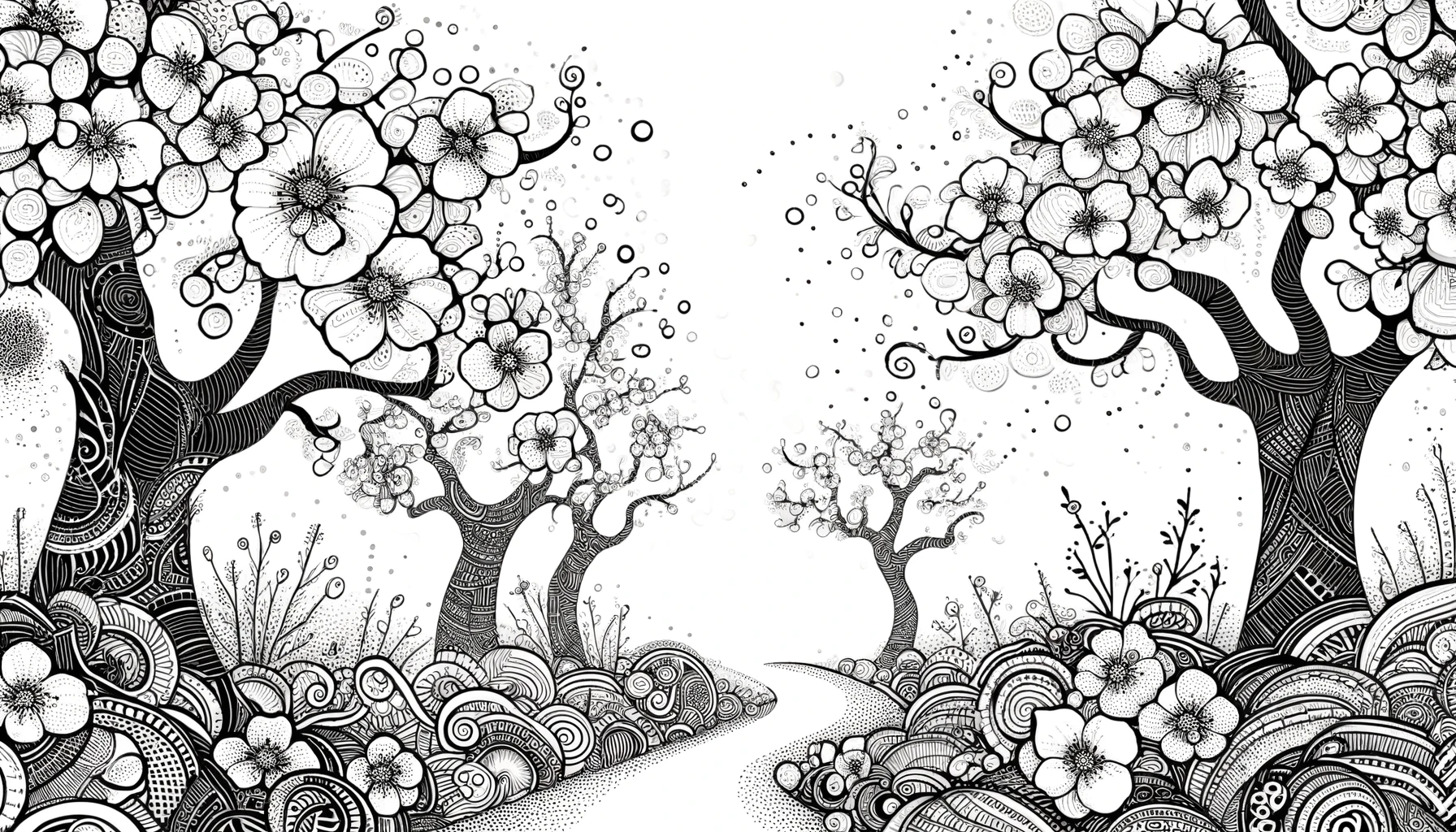
Unveiling the Magic of Landscape Drawing
Why Landscape Drawing is a Must-Try Art Form
Landscape drawing is more than just a creative pursuit; it’s an invitation to connect with the world around you in a profound and personal way. As you embark on this artistic journey, you’ll discover that capturing the essence of a scene is both exhilarating and meditative. Whether you’re sketching the rolling hills outside your window or the bustling streets of a distant city, landscape drawing allows you to interpret and record the beauty of the environment in a unique, tangible form.
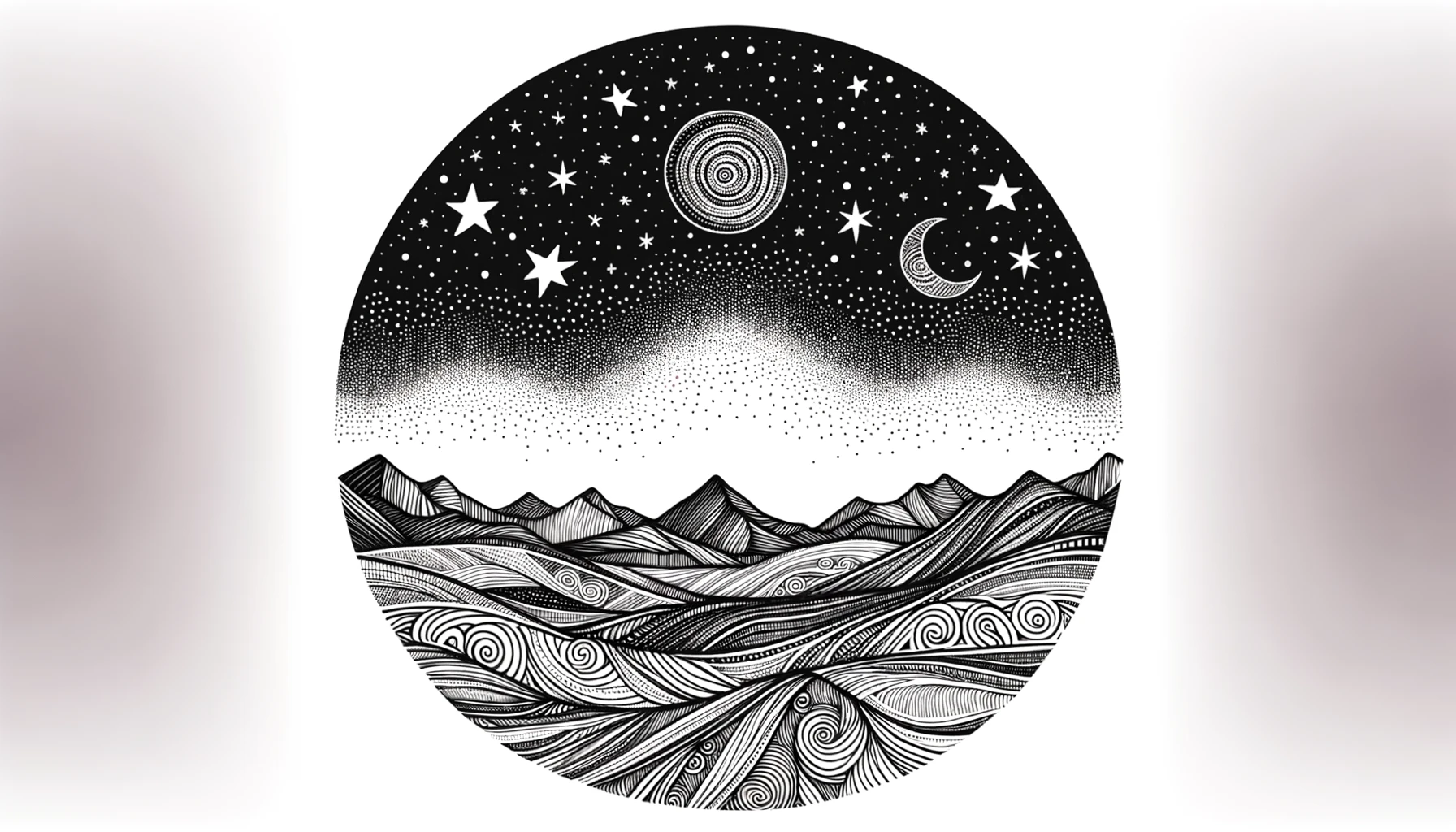
Unlike other art forms like figure drawing or gesture drawing, landscapes provide a vast canvas where the sky is literally the limit. You’ll find joy in the challenge of distilling the grandeur of nature onto paper. Each stroke of your pencil not only replicates a view but also conveys the emotions and atmosphere of the moment. It’s a must-try for anyone who wants to deepen their appreciation for natural and urban landscapes alike.
The Joy of Capturing the World on Paper
The act of landscape drawing can be incredibly rewarding. There’s something magical about seeing a scene come to life as your hands move across the page. With landscape drawing, the world becomes your muse, offering an endless array of subjects and settings to inspire your artwork. From the tranquility of a sunset beach to the chaotic charm of a city skyline, each environment holds the potential for a stunning piece of art.
Imagine the satisfaction of translating the world’s beauty into your own creative language, using techniques like perspective drawing, shading, and texture to add depth and dimension. As you grow more comfortable with your skills, you might even find yourself adding personal touches that reflect your artistic voice, such as stylized line drawing or expressive sketching.
Landscape drawing is not just about creating art; it’s about becoming more present and aware of your surroundings. It encourages you to slow down, observe, and appreciate the nuances of color, light, and form that you might otherwise overlook. So pick up a pencil, find a view that speaks to you, and let the magic of landscape drawing transport you to a world of creativity and wonder. And if you’re just getting started, don’t hesitate to check out our beginner-friendly guides on how to draw and doodling to kickstart your artistic adventure.
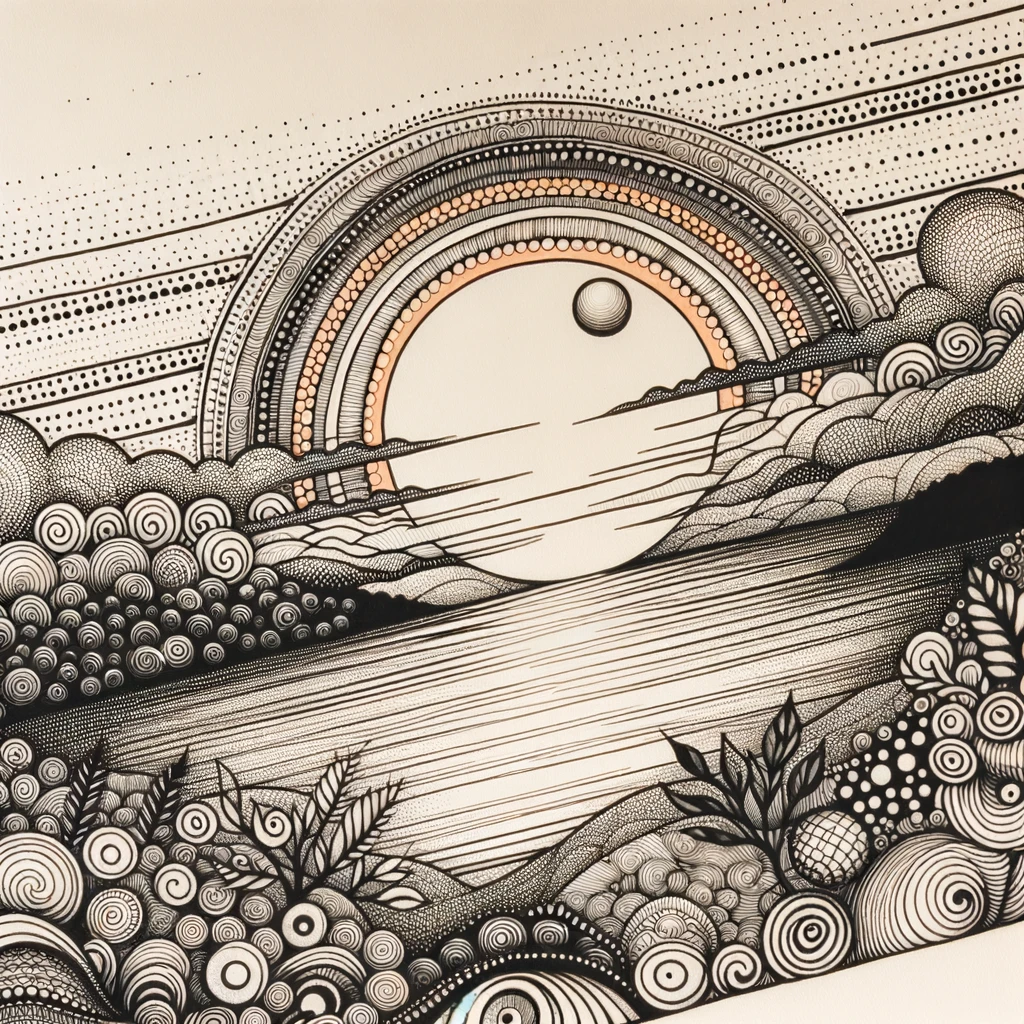
Getting Started with Landscape Drawing
Embark on a creative venture into the enchanting world of landscape drawing, where every sketchbook page becomes a window to breathtaking vistas and serene settings.
Essential Tools for Your Drawing Adventure
Before setting out on this artistic journey, you’ll need to equip yourself with a few essential tools. The foundation of your toolkit should include a range of pencils for different shades and lines. A good quality sketchbook with heavy-weight paper is ideal for practicing and capturing your landscapes. Don’t forget a sharpener and eraser for refining your work!
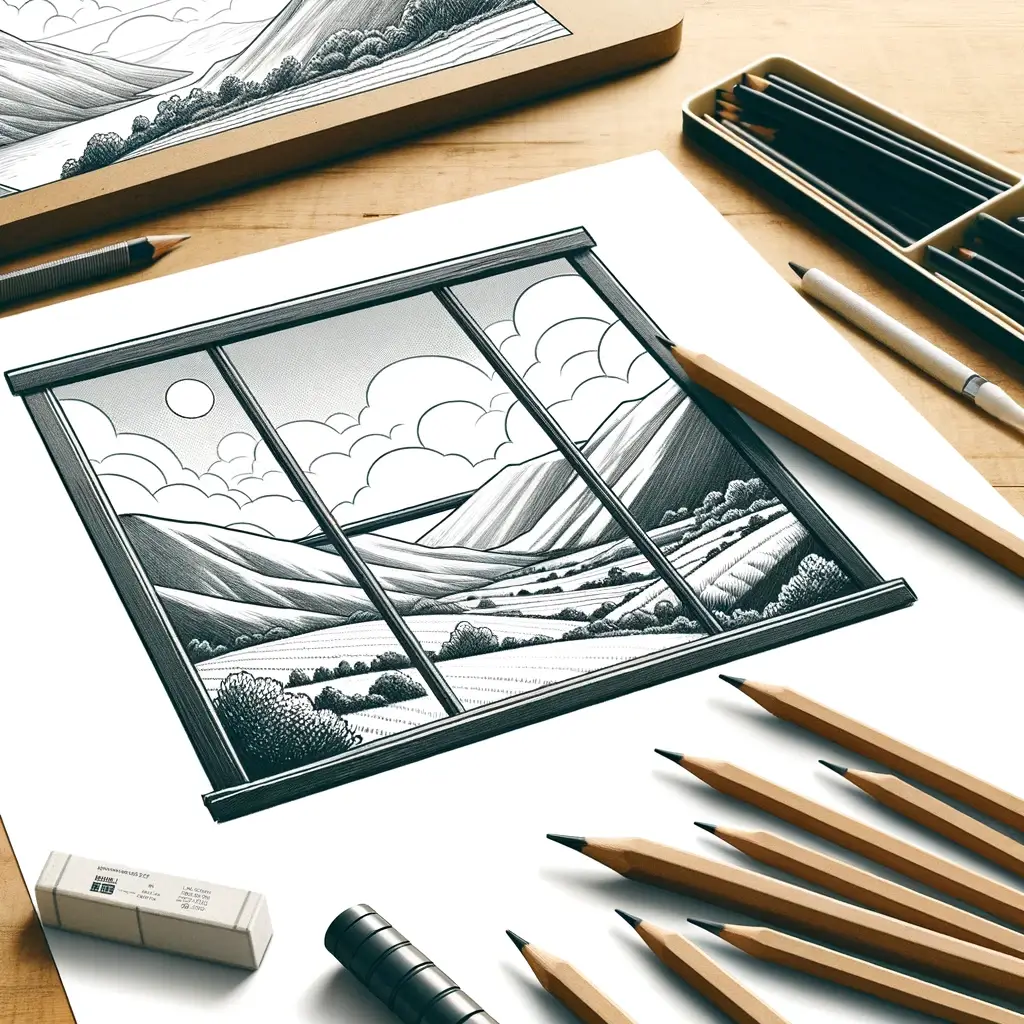
Here’s a basic list of tools you’ll need:
- Graphite pencils (variety of grades from 2H to 8B)
- Sketchbook with at least 150 gsm paper
- Pencil sharpener
- Eraser (kneaded and standard)
- Blending stumps or tortillons for smooth shading
Finding Your Perfect Landscape
Your journey into landscape drawing begins with discovering the perfect scene to capture. Whether you’re enchanted by the grandeur of mountains or soothed by the gentle flow of a river, your subject should speak to you personally. Take a stroll in nature or browse your own photo collection for inspiration.
Consider these tips when seeking out landscapes:
- Look for a variety of textures and elements to challenge your skills.
- Observe the way light interacts with the environment at different times of day.
- Find a balance between simplicity and complexity to keep your drawing engaging but not overwhelming.
Remember, landscape drawing is not just about replicating a view; it’s about interpreting and expressing it through your unique perspective. Explore our resources on how to draw and pencil drawing to help you get started on this artistic endeavor. Whether you’re refining your sketching techniques or exploring the realms of perspective drawing and line drawing, remember that each stroke brings you closer to mastering the art of landscape drawing.
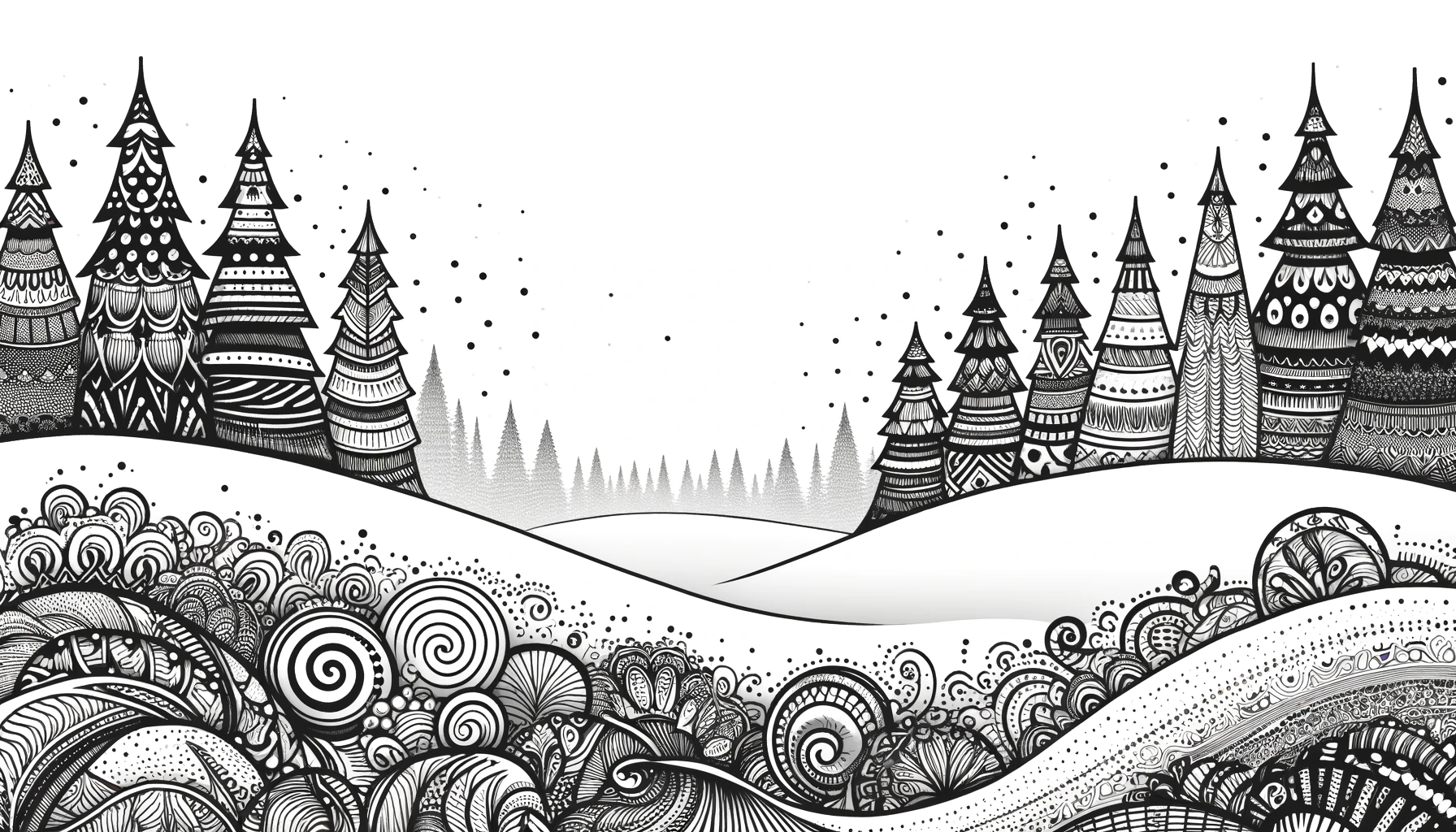
Basic Techniques to Master
Embarking on the adventure of landscape drawing, you’ll discover an array of techniques that will elevate your artwork and bring your depictions of nature to life. Let’s dive into the fundamental skills that form the bedrock of successful landscape drawing.
Understanding Perspective in Landscapes
Perspective is the cornerstone of creating a believable space on your paper. It’s all about how you portray depth, making faraway objects smaller and less detailed than those in the foreground. Mastering perspective allows you to illustrate the vastness of landscapes with authenticity.
To start, familiarize yourself with the terms ‘horizon line’ and ‘vanishing points’. These are the invisible lines and points that shape how you view a scene. A simple exercise involves drawing a straight road or a row of trees diminishing in size as they recede into the distance.
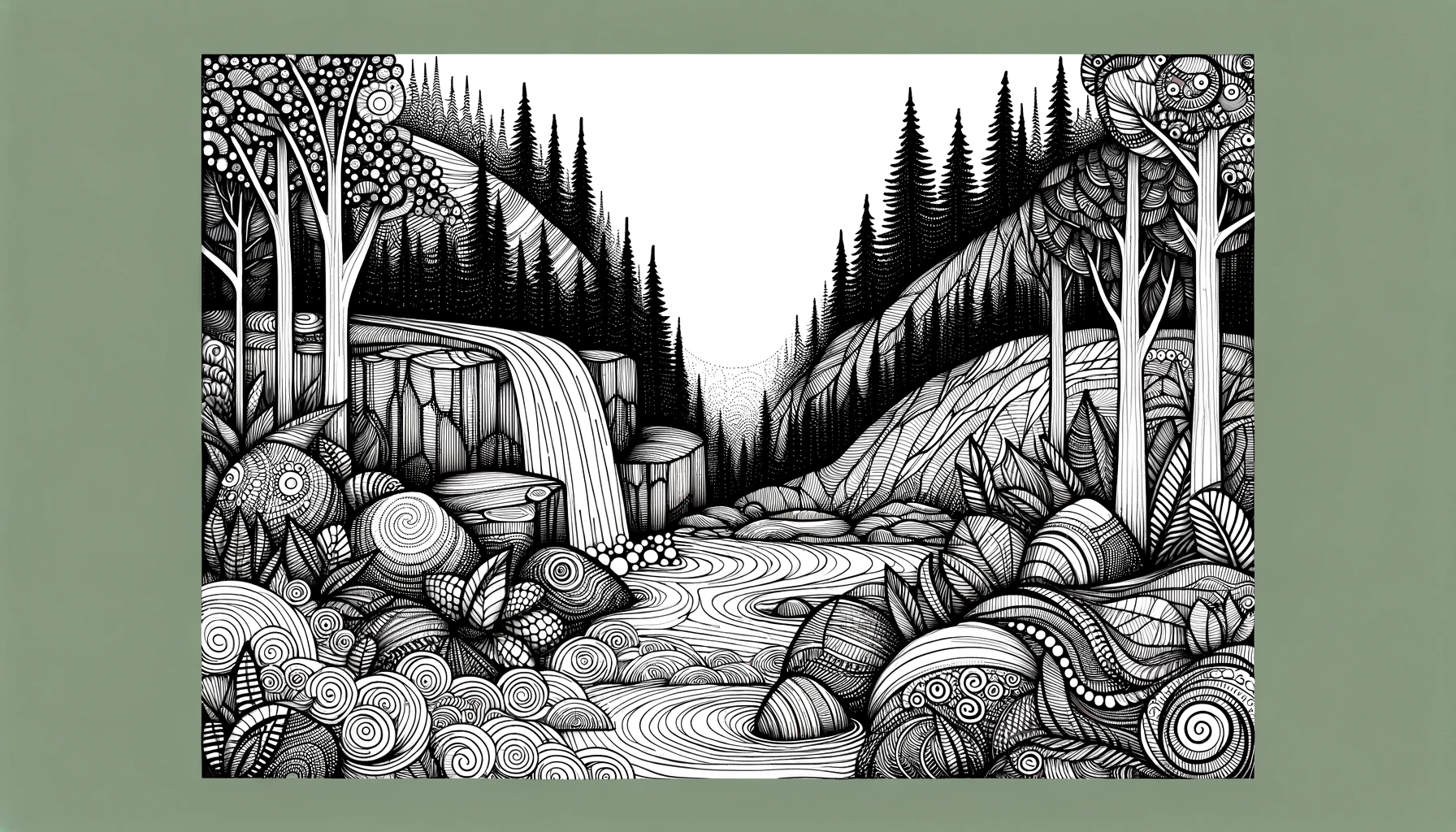
The Art of Shading and Texture
Shading isn’t just about making parts of your drawing darker; it’s about using gradations to give form and volume to the elements within your landscape. The direction and density of your pencil strokes can create the illusion of a variety of textures found in nature, like the roughness of bark or the softness of grass.

A useful technique to practice is cross-hatching, where you build up shading through layers of intersecting lines. This method can be particularly effective for adding density to wooded areas or giving rocks a rugged appearance.
Capturing Light and Shadow
Light and shadow are the dramatic elements of your landscape drawing. They define the time of day, the weather, and the mood of your scene. By observing where the light falls and where the shadows lie, you can create a sense of realism that resonates with your viewer.
Begin by deciding on a light source, and then determine how it interacts with the objects in your drawing. Where does the shadow cast, and how does it shape the form of the landscape? Experiment with different lighting scenarios to see how they change the ambiance of your work. The interplay of light and shadow is an exciting area to explore, and our section on pencil drawing can help you harness this powerful tool.
By honing your understanding of perspective, mastering the subtleties of shading and texture, and playing with light and shadow, you’re well on your way to creating captivating landscape drawings. Remember, each sketch you make is a step forward in your artistic journey. So, grab your tools, seek inspiration from the environment around you, and let your creative spirit roam free across the pages of your sketchbook.
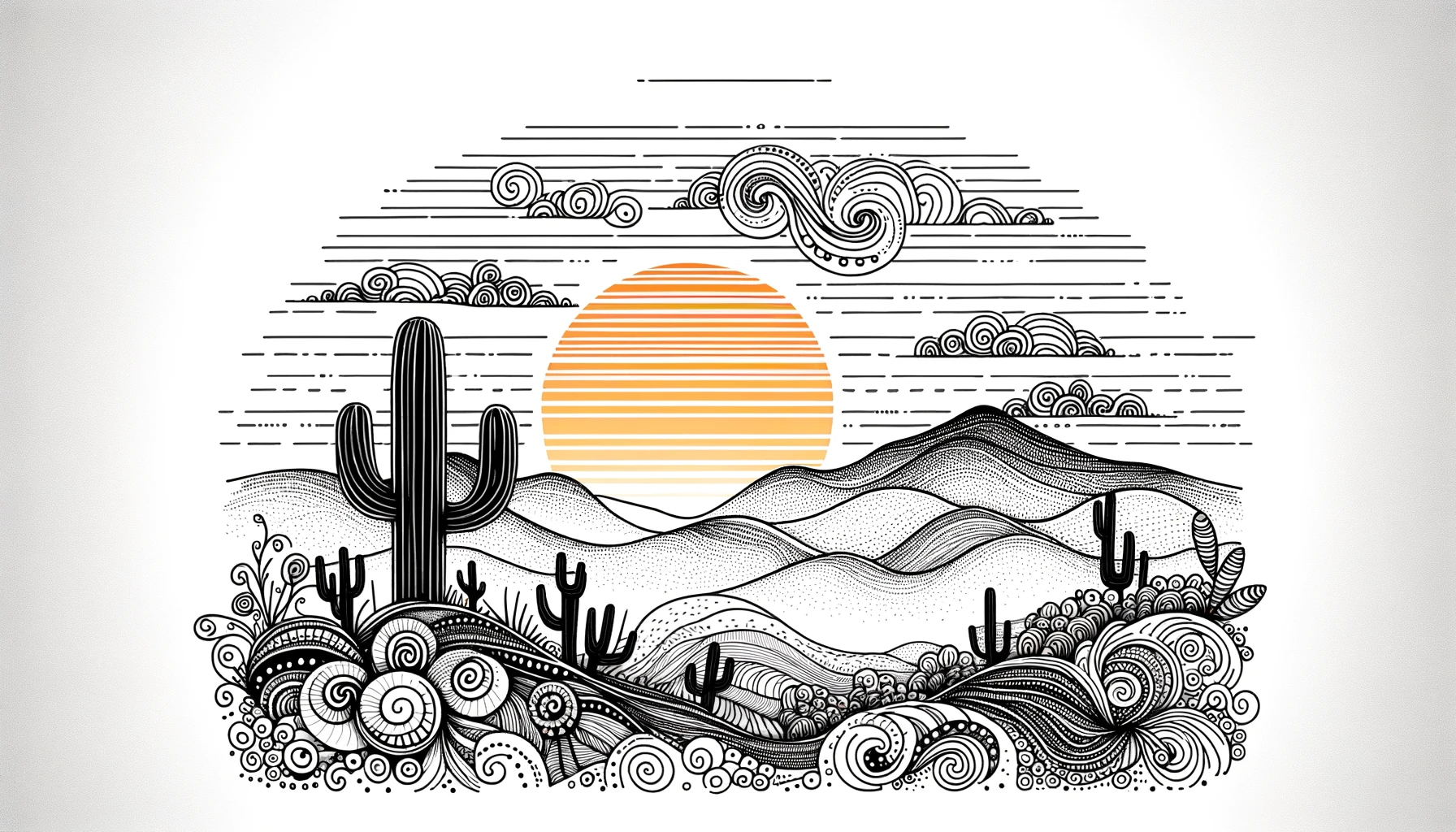
Composition Tips for Eye-Catching Landscapes
Transforming your sketchbook into a collection of breathtaking landscapes is an exhilarating process. Composition is key to creating a visually appealing landscape drawing that captures the viewer’s interest and guides their eye through the scene. Let’s dive into some foundational composition techniques that you can apply to your landscape artworks.
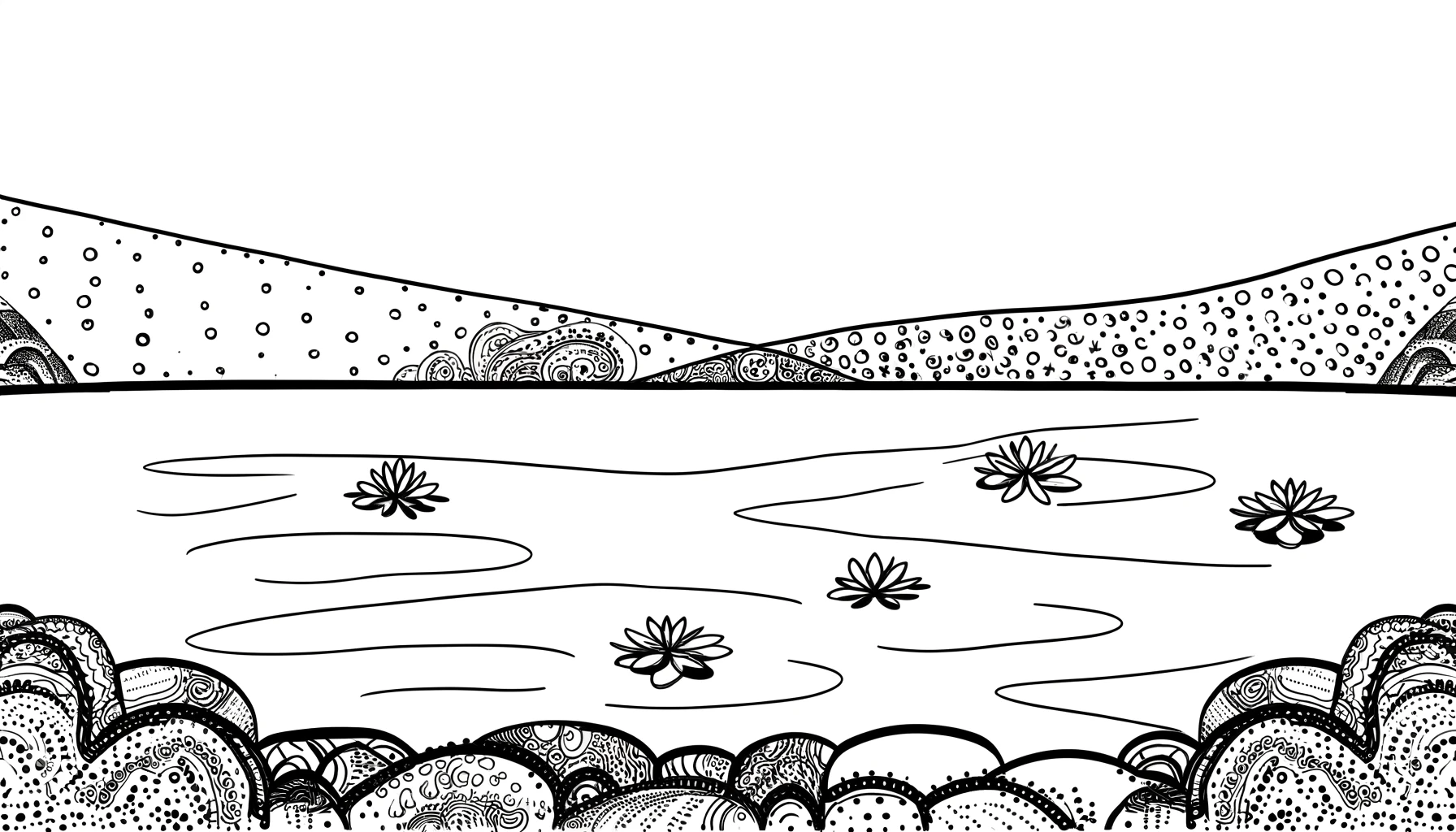
The Rule of Thirds in Landscape Drawing
The rule of thirds is a classic composition guideline that you’ve likely encountered before. Imagine your drawing space is divided into nine equal parts by two equally spaced horizontal lines and two equally spaced vertical lines. The points where these lines intersect are the sweet spots of your composition.
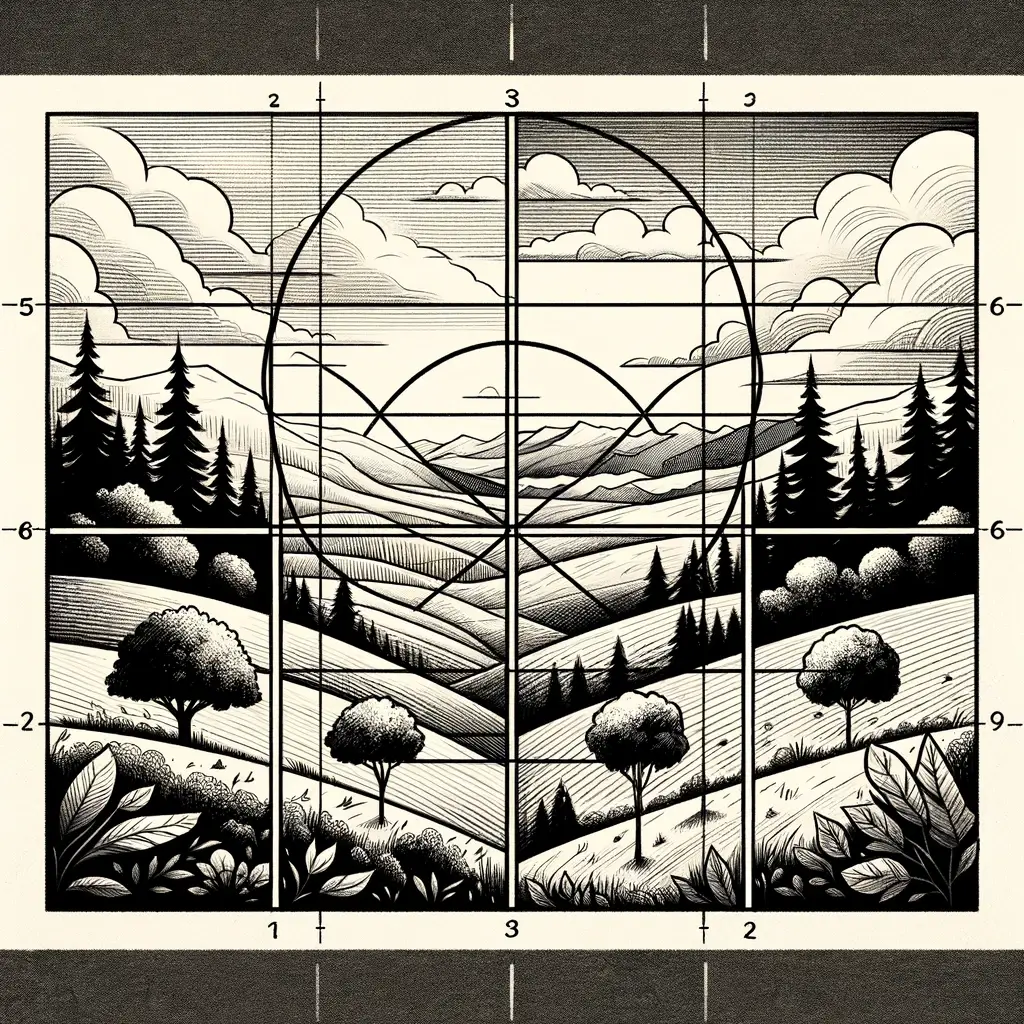
When you’re sketching a landscape, aim to place the most interesting elements of your scene along these lines or at their intersections. For instance, the horizon line in your landscape drawing could align with one of the horizontal lines, while a majestic tree or a mountain peak could be placed at one of the intersection points.
| Intersection Points | Ideal Elements to Place |
|---|---|
| Top-left | A tree or building |
| Top-right | A mountain peak or flock of birds |
| Bottom-left | A flower or rock |
| Bottom-right | A person or animal |
Using the rule of thirds helps create a balanced and dynamic composition that is pleasing to the eye.
Balancing Elements for Harmonious Scenes
Creating harmony in your landscape drawings involves balancing various visual elements to achieve a sense of stability. Consider the distribution of objects, their sizes, and how they interact with one another on your paper.
A harmonious scene might feature a large element on one side, such as a group of trees, counterbalanced by a smaller, detailed element on the opposite side, like a quaint cottage. This balance doesn’t have to be symmetrical but should feel natural and unforced.
Remember, variety in shapes, sizes, and textures can add interest and depth to your landscapes.
Using Focal Points to Draw Interest
A focal point is the area of your landscape drawing that you want to draw the most attention to. It’s the star of the show, the element that stands out due to its contrast, color, or significance in the scene.
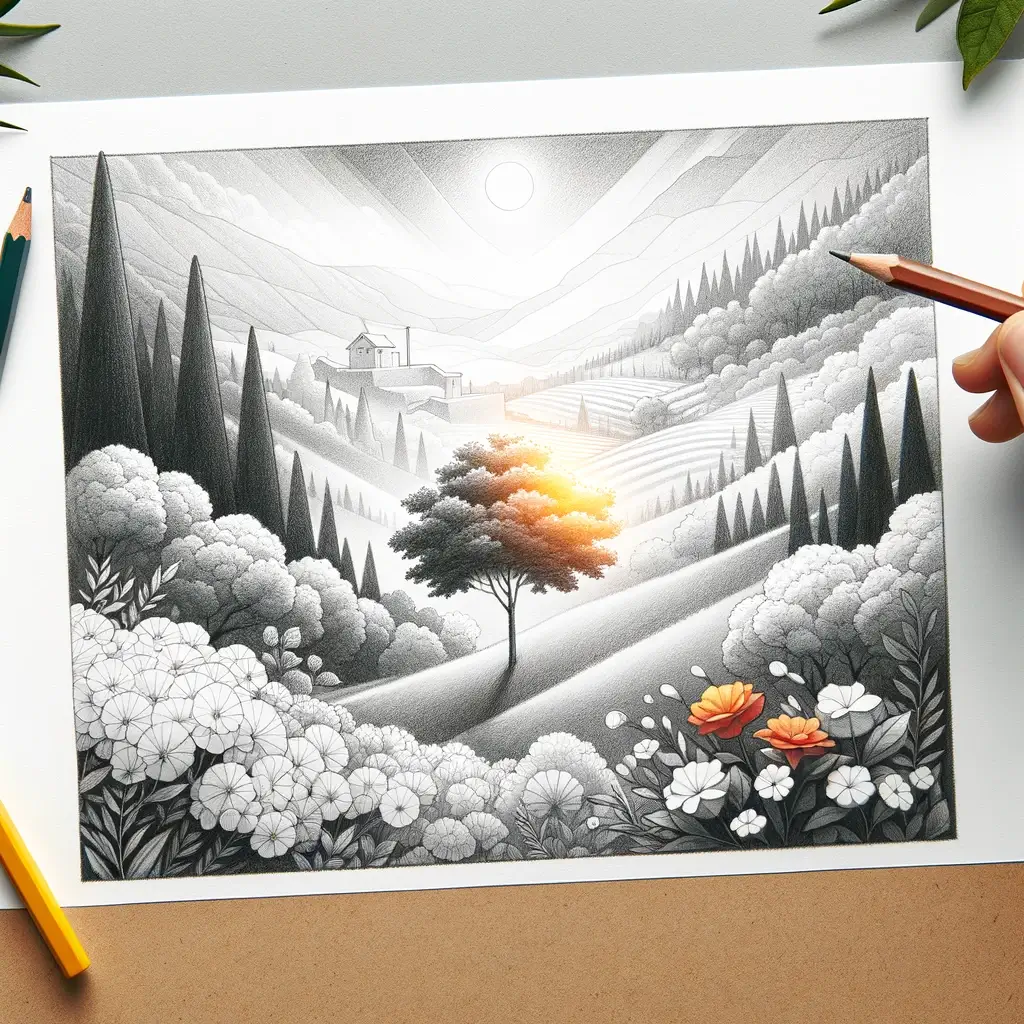
You can create a focal point by:
- Using a contrast of light and dark tones.
- Introducing a pop of color in a predominantly monochromatic scene.
- Adding intricate detail to one area while keeping the rest more subdued.
Your focal point should be strategically placed using the rule of thirds for maximum impact. As you develop your landscape drawing skills, experiment with different focal points to see how they change the feeling and direction of your artwork.
With these composition tips, your landscape drawings are sure to captivate anyone who lays eyes on them. Keep your pencil moving, and watch as your sketchbook transforms into an array of stunning landscapes that tell a story of your artistic journey.
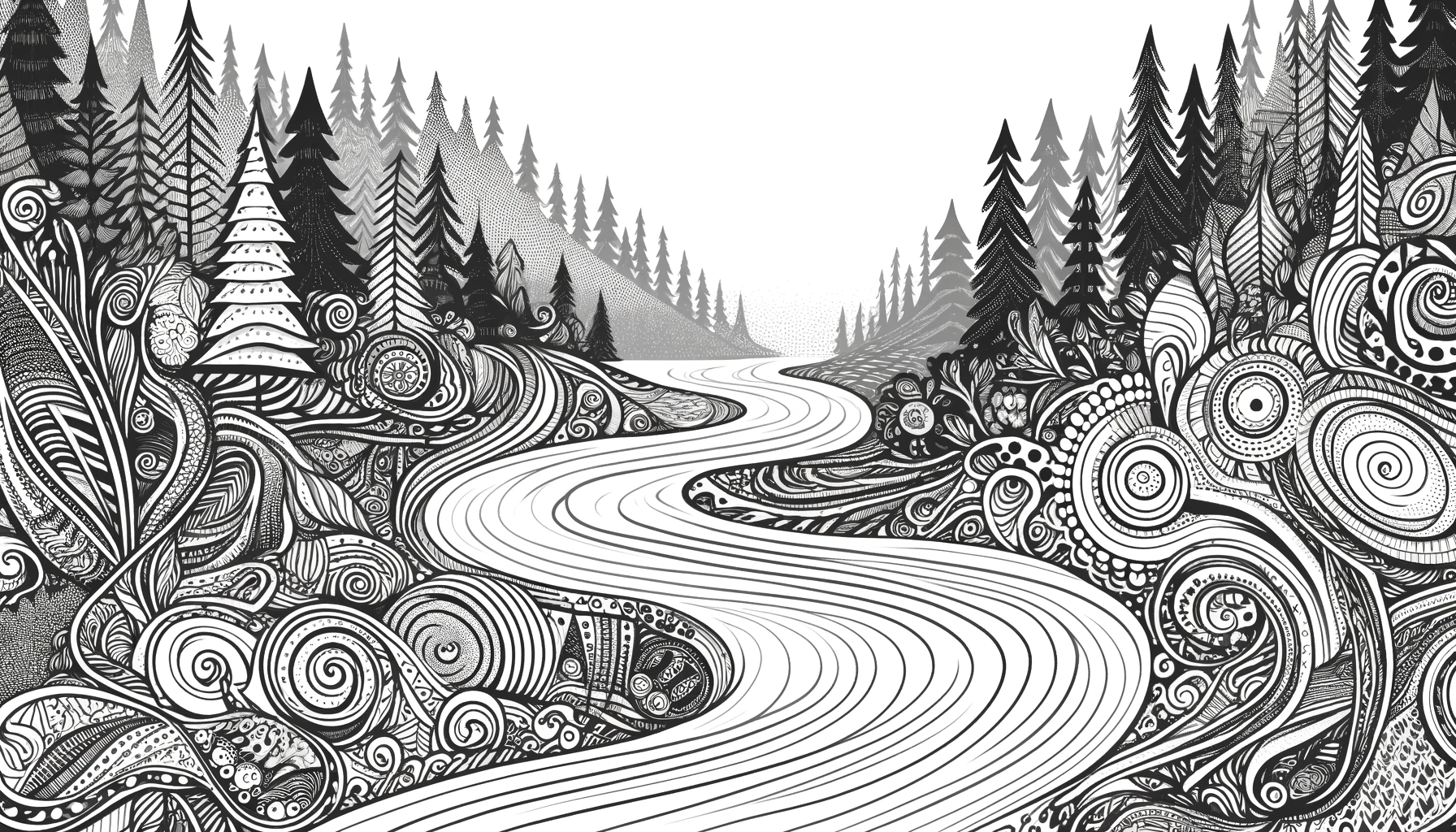
Drawing Different Types of Landscapes
Landscape drawing offers an exhilarating challenge to capture the essence of nature’s vastness and beauty. Each type of landscape presents its own set of delightful intricacies and allows you to explore different techniques and styles. Whether you’re sketching the rolling countryside, the solemnity of mountain ranges, or the serene flow of water, each landscape will add depth to your artistic repertoire.
Rolling Hills and Lush Fields
Imagine sitting atop a gentle hill, overlooking a valley of greenery that stretches into the horizon. To render the rolling hills and lush fields, start by lightly sketching the undulating lines that define the land’s contours.
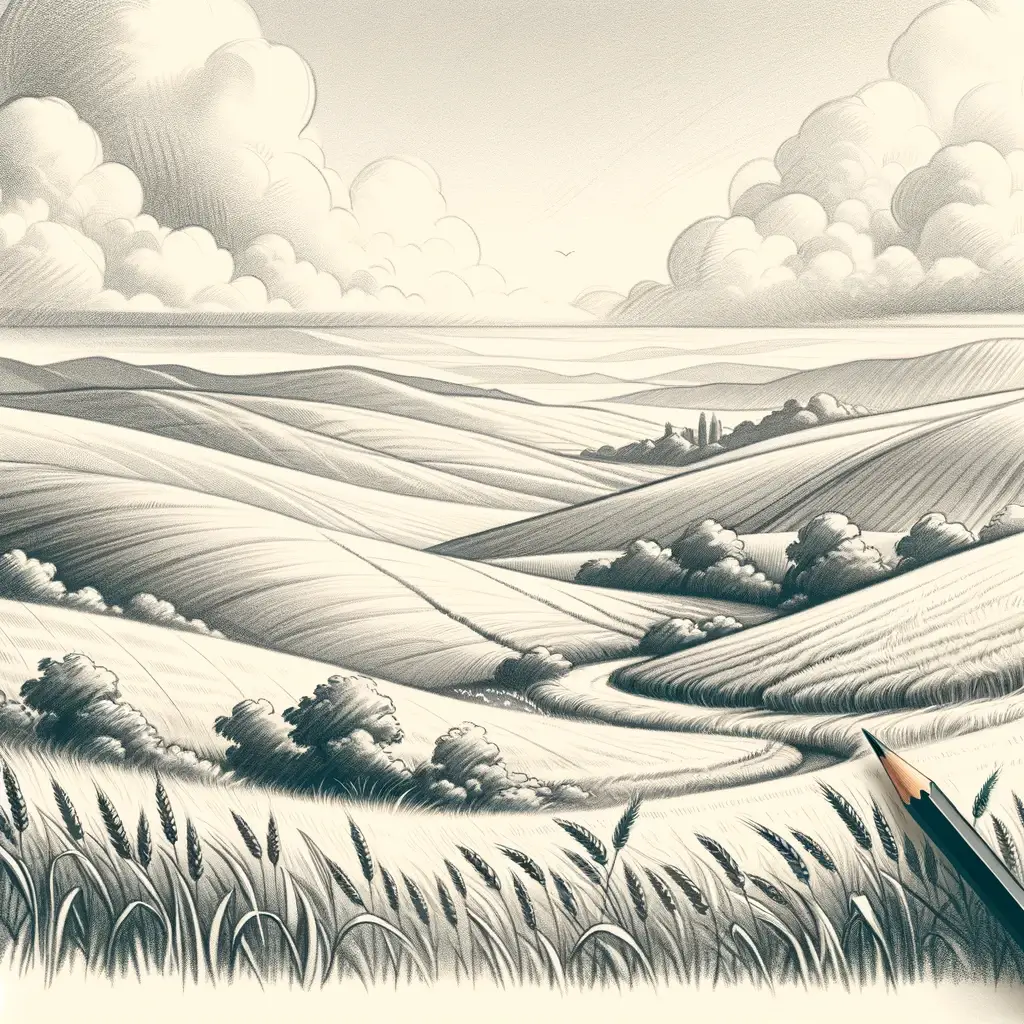
Employ line drawing techniques to outline the forms and use a variety of shading methods to create volume and depth. The key to capturing the softness of the hills is in the subtlety of your gradient transitions. Use your pencils to layer and blend, creating the illusion of grass swaying in the breeze.
| Technique | Application in Rolling Hills | Tools Suggested |
|---|---|---|
| Gradient Shading | To show the curves of the hills | Soft pencils (B, 2B) |
| Texturing | To suggest grass and fields | Fine-tip pens, colored pencils |
| Layering | To build color depth and richness | Colored pencils, blending stumps |
Majestic Mountains and Rugged Terrain
The grandeur of mountains requires a bold approach. Your strokes should be firm and confident as you outline the jagged peaks and slopes. Remember to pay attention to the direction of light, as it will inform where the darkest shadows and brightest highlights fall, adding a dramatic effect to your mountainscape.
| Technique | Application in Mountains | Tools Suggested |
|---|---|---|
| Cross Hatching | For shadows and textures | Fine liners, mechanical pencils |
| Gesture Drawing | To suggest rough terrain | Charcoal, soft pencils (6B) |
| Highlighting | To emphasize sunlit areas | Erasers, white pencils |
Tranquil Waters and Reflective Surfaces
Water scenes can be both calming and complex to draw. When you approach tranquil waters and reflective surfaces, your goal is to mirror the serenity they embody. Start with horizontal lines to lay the water’s flat surface, and use perspective drawing to guide the viewer’s eye through the scene.
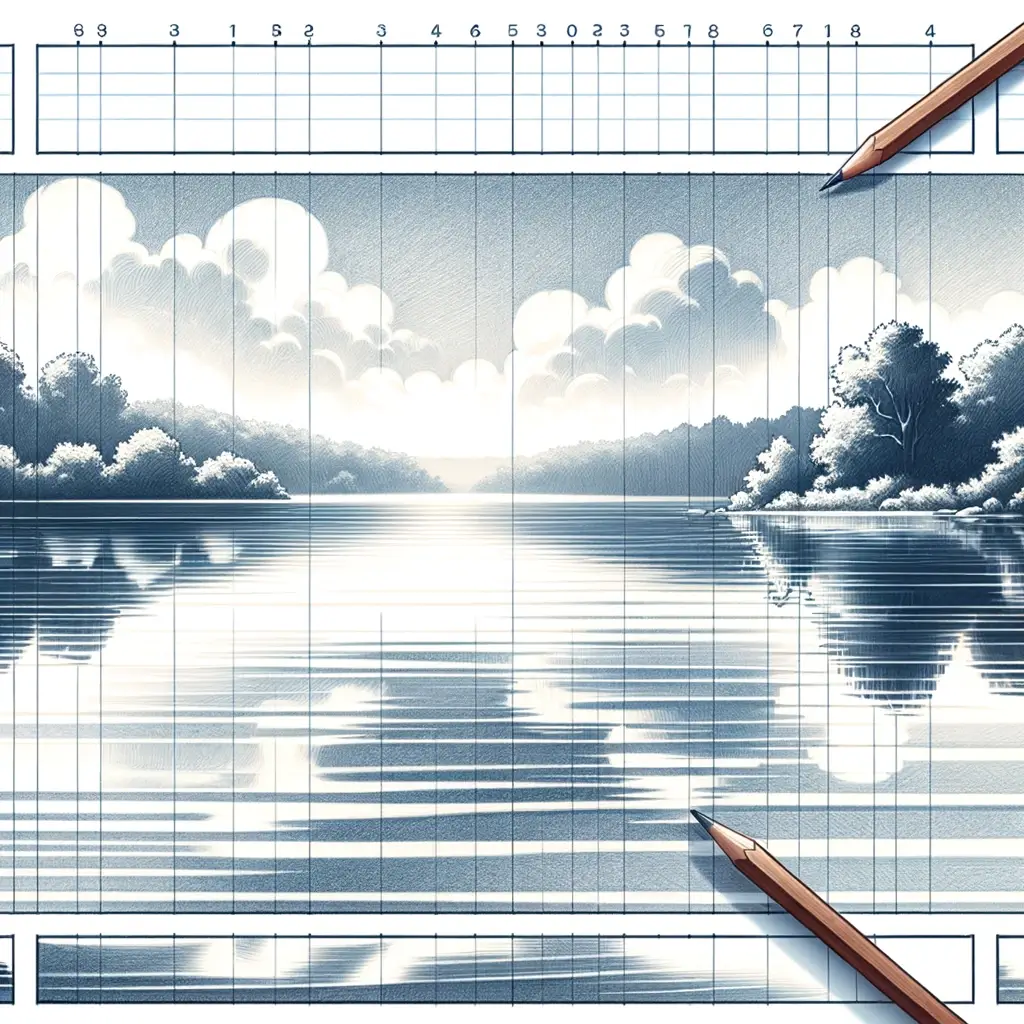
Create reflections by mirroring the elements above the waterline and use subtle shading to suggest ripples. The key is in the details—slight variations in tone can make your water look either perfectly still or gently lapping at the shore.
| Technique | Application in Waterscapes | Tools Suggested |
|---|---|---|
| Reflective Symmetry | For water reflections | Graphite pencils, fine-tip pens |
| Tonal Variation | To show water depth and movement | Blending stumps, soft pencils |
| Negative Space | To create ripples and waves | Erasers, hard pencils (H, 2H) |
Each landscape type offers a unique opportunity to grow as an artist. You’ll discover that with each drawing, your confidence will soar, and the techniques you learn will enhance your overall drawing skills. As you progress, remember to revisit foundational skills through guides like how to draw and enjoy the simplicity of doodling to keep your creativity flowing. Share your landscape masterpieces and take pride in how they reflect your artistic journey.
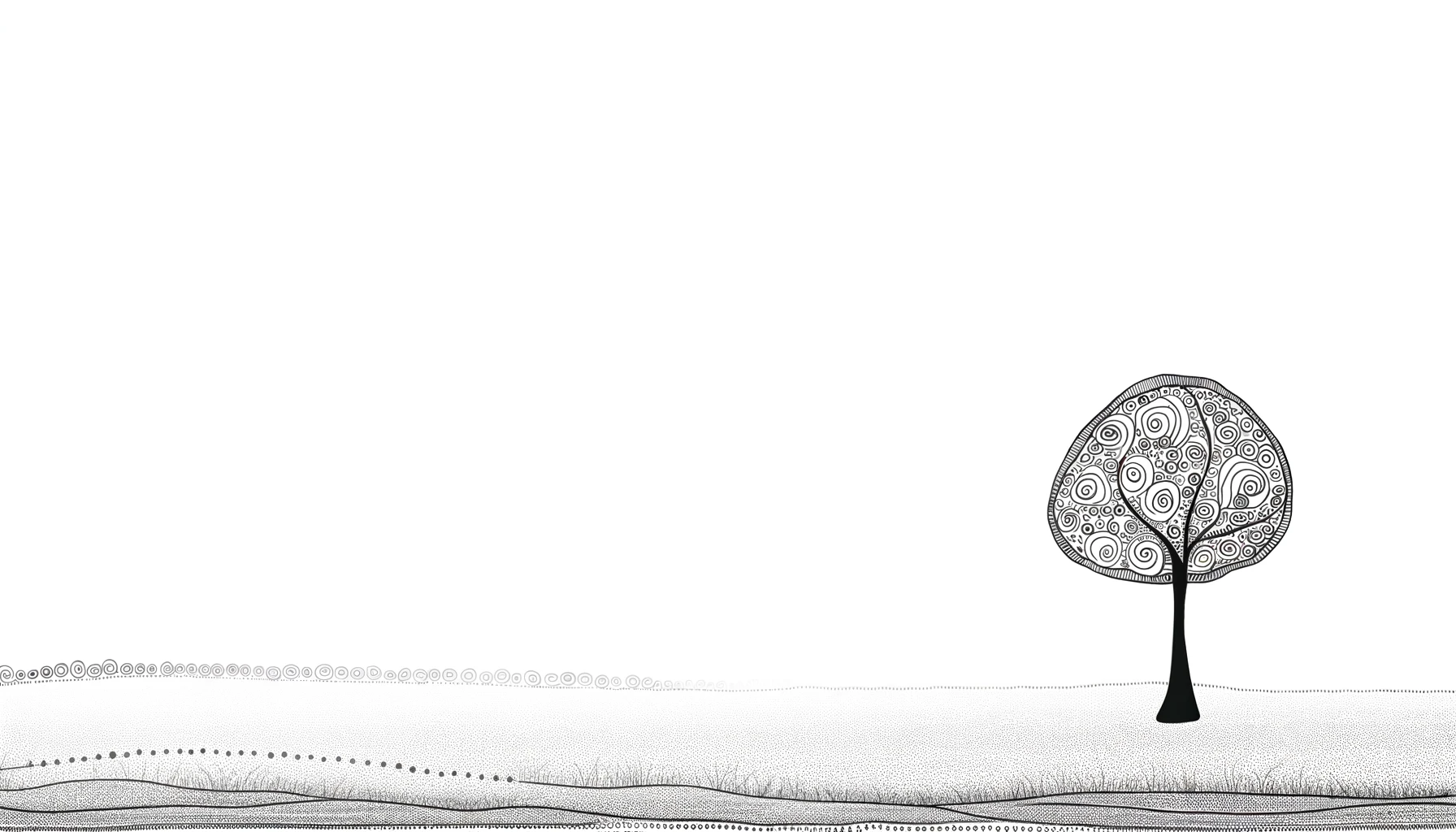
Enhancing Your Skills
Practice Makes Perfect: Regular Sketching Tips
You’ve probably heard the saying “practice makes perfect,” and it’s especially true when it comes to landscape drawing. Regular sketching not only improves your technique but also helps you develop your unique style. Here are some tips to keep you sketching regularly:
- Dedicate a Time: Set aside a specific time each day or week for sketching. It doesn’t have to be long; even 15 minutes can make a difference.
- Sketch on the Go: Keep a small sketchbook with you for doodling when inspiration strikes, no matter where you are.
- Challenge Yourself: Try different subjects or techniques like cross hatching or line drawing to push your boundaries.
- Draw from Life: Whenever possible, sketch from real landscapes rather than photos to get a better feel for depth and space.
- Review and Reflect: Look back at your previous work to see your progress and identify areas for improvement.
Remember, every stroke you draw enhances your skills a little more, so keep that pencil moving!
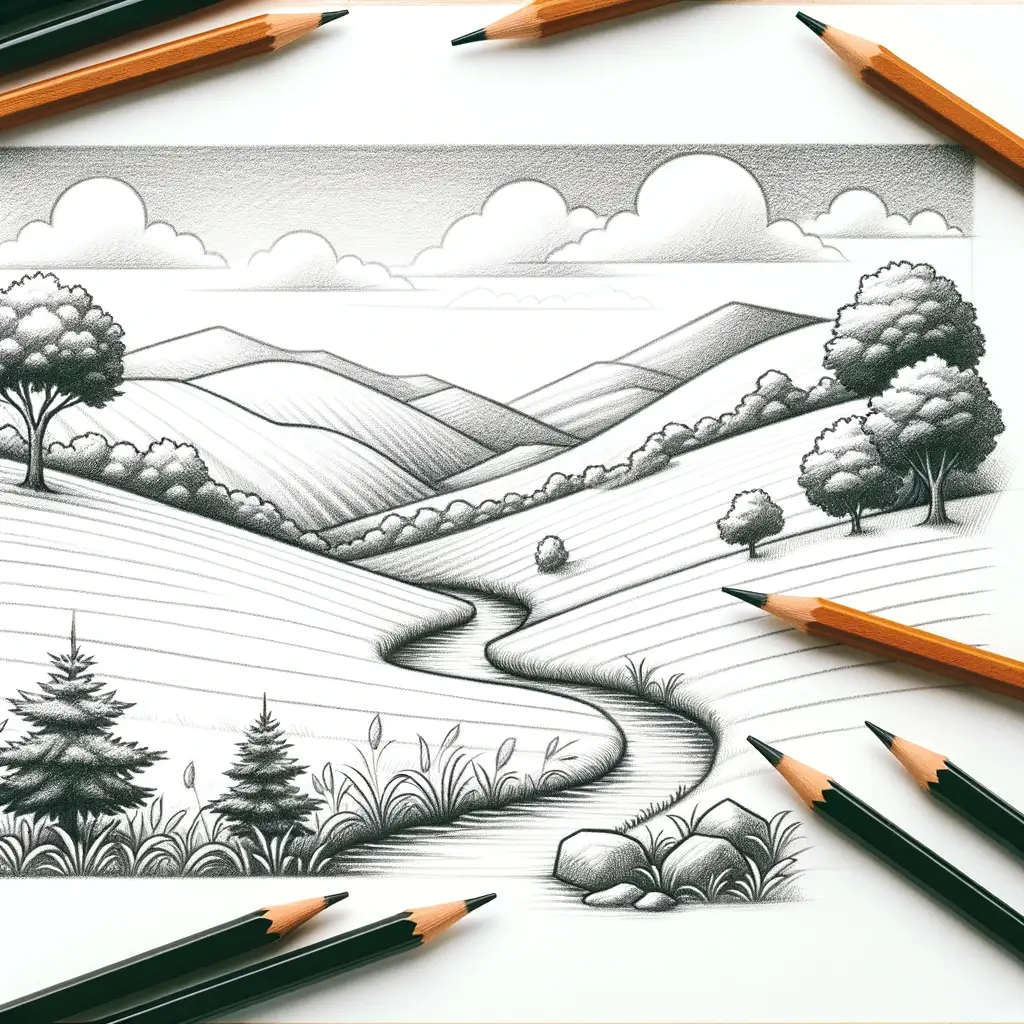
Taking Inspiration from the Greats: Study Famous Landscape Artists
Studying the work of famous landscape artists can provide a wealth of inspiration and learning. By examining their techniques, you can discover new ways to approach your drawings. Consider these actions:
- Art Books and Galleries: Spend time with art books or visit galleries to see the works of renowned landscape artists up close.
- Copy Masterworks: Try replicating a masterwork. This age-old practice can give you insight into the techniques and decisions of the greats.
- Learn Their Histories: Understanding the context in which these artists worked can deepen your appreciation and influence your approach to landscape drawing.
By combining practice, community engagement, and the study of master landscape artists, you’re well on your way to refining your skills and developing as an artist. Your journey in landscape drawing is bound to be as rich and varied as the vistas you’re capturing on paper. Keep exploring, keep learning, and most importantly, keep drawing!
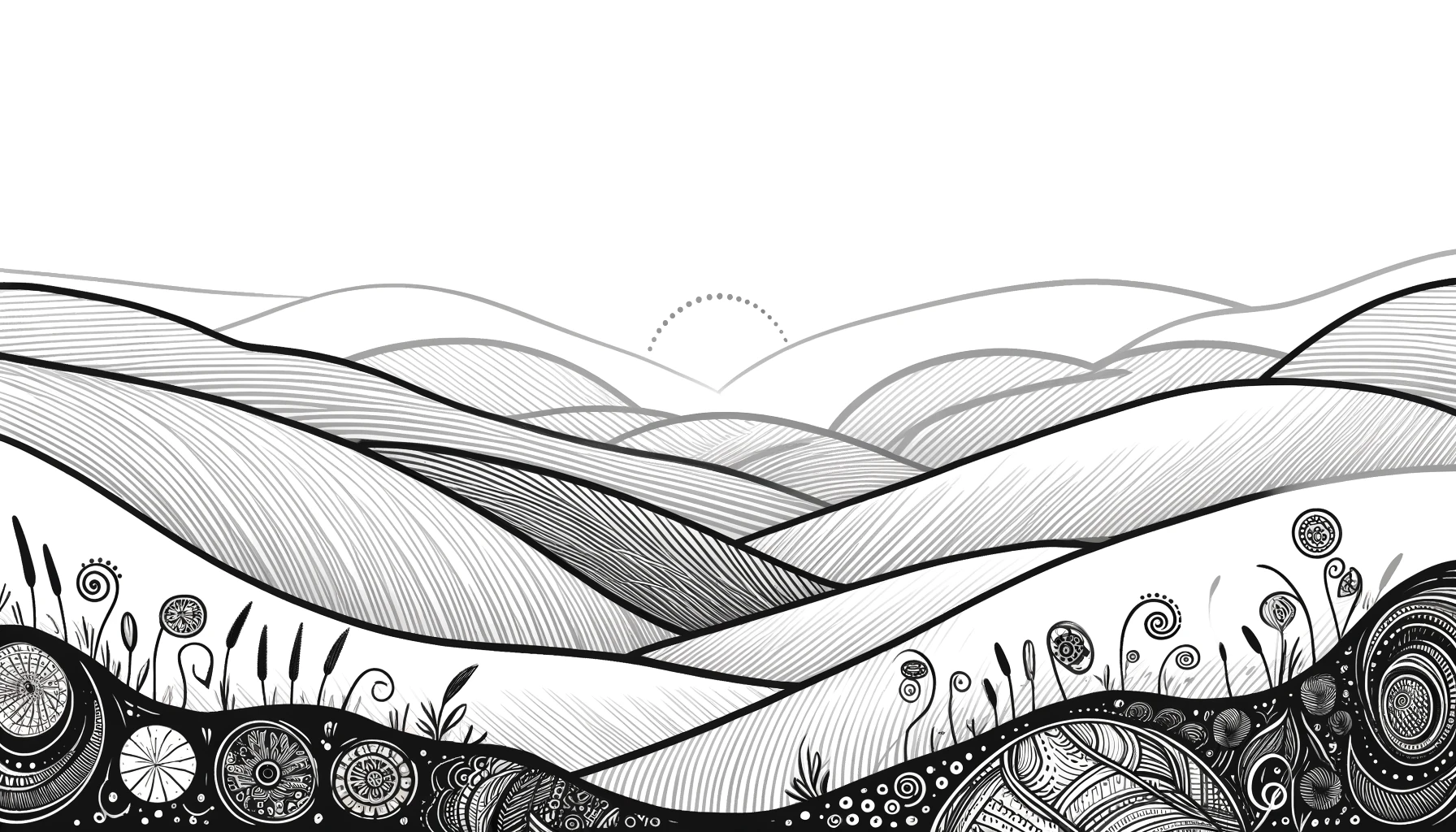
Overcoming Common Challenges
As you continue your adventure into landscape drawing, you’ll inevitably encounter a few bumps along the road. Don’t worry, though! Each challenge is an opportunity to grow and refine your skills. Let’s look at some common hurdles you might face and ways to gracefully leap over them.
Dealing with Proportions and Scale
One of the trickiest elements in landscape drawing is getting the proportions and scale accurate. It’s easy to feel overwhelmed when trying to translate the vastness of nature onto your sketchpad. But here’s a secret: using a simple grid method can be a game-changer. By dividing your drawing into equal sections, you can focus on one part at a time, ensuring that each element is in proper relation to the others.
Additionally, consider practicing perspective drawing. Mastering one-, two-, or even three-point perspective will allow you to create depth and realism in your landscapes. Remember, the more you practice, the better you’ll get at judging distances and sizes by eye.
Navigating Complex Nature Elements
Nature is complex, with its intricate textures and forms. When you’re starting out, you might find it challenging to capture the essence of foliage, rocks, or water. Instead of getting bogged down in the details, focus on the overall shapes and patterns.
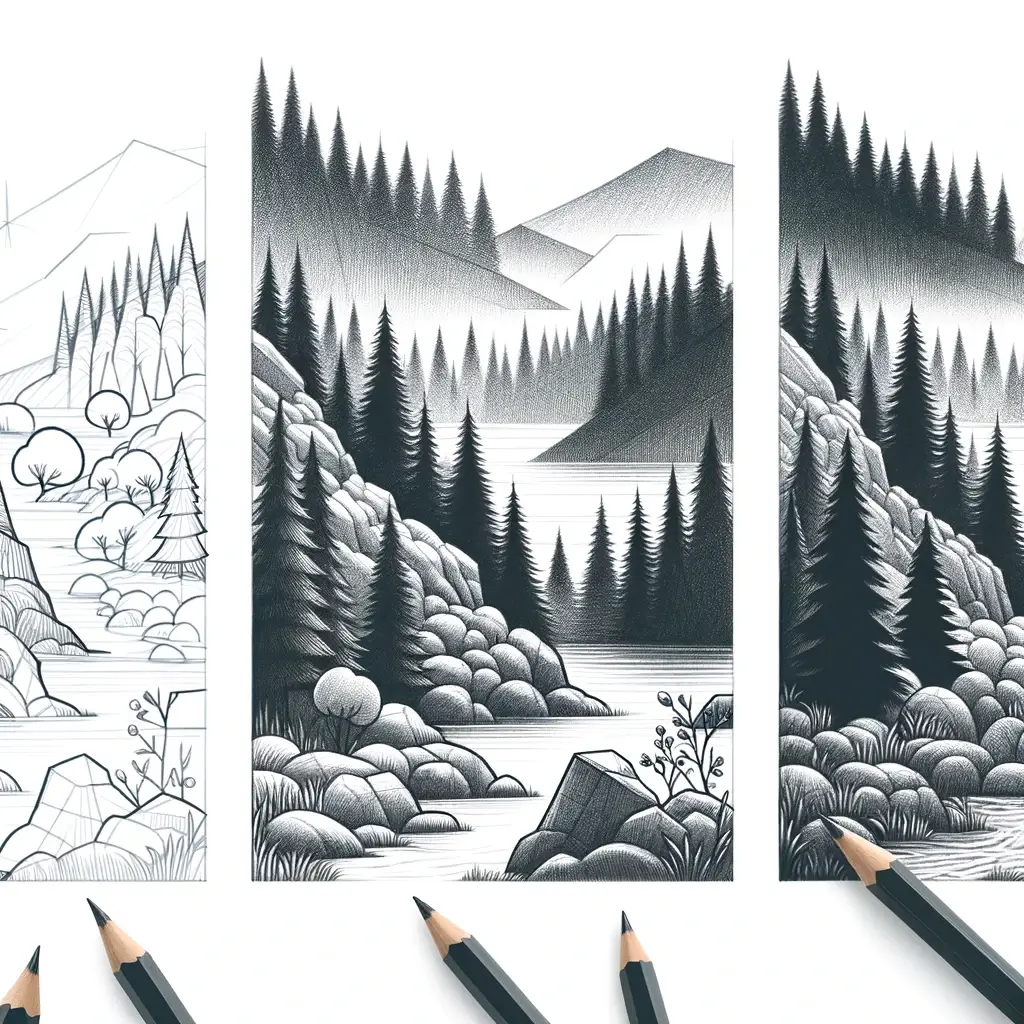
Here’s a fun exercise: try doodling different nature elements without looking at a reference. This will train your hand to move freely and your mind to simplify complex shapes into more manageable forms. When you’re comfortable, bring those skills into your landscape drawing for a fresh and lively effect.
Adjusting to Changing Light and Weather Conditions
Light and weather can transform a landscape in a matter of minutes. It’s part of what makes drawing from life so thrilling! When you’re out in the field, work quickly to capture the essence of the scene. Start with a pencil drawing to lay down the basic composition, then add layers of shading to represent the changing conditions.
Keep in mind that light is what gives your drawing dimension. Study how light interacts with objects and surfaces. Practice by setting up a still life with a strong light source and sketch the shadows and highlights. This exercise will enhance your ability to translate those fleeting moments of light into your landscape drawings.
By embracing these challenges as part of your artistic journey, you’ll not only improve your technical skills but also develop a deeper connection with the landscapes you draw. Every sketch you create, regardless of its imperfections, is a step forward on your creative path. Share your progress and celebrate each victory, big or small, and before you know it, you’ll be creating landscapes that truly resonate with the beauty you see in the world.
Draw like a PRO in 30 days28 Breathtaking Landscape Drawing Ideas You Can Master in No Time
- Sunset over a Calm Lake
- Rolling Hills at Dawn
- A Lone Tree on a Misty Morning
- A River Cutting Through a Forest
- Starry Night Sky Over Mountains
- A Path Lined with Cherry Blossoms
- Coastal Cliffs with Crashing Waves
- A Serene Pond with Water Lilies
- A Winter Wonderland with Snowy Pines
- A Desert Scene with a Cactus at Sunset
- Reflections on a Crystal Clear Lake
- A Rocky Waterfall in a Lush Forest
- An Old Wooden Bridge Over a Creek
- A City Park in Autumn
- A Mountain Vista at Twilight
- Moonlit Beach with Palm Trees
- A Field of Wildflowers in the Breeze
- A Secluded Cabin in a Snowy Forest
- The Grand Canyon at Midday
- A Vineyard in Early Fall
- A Tropical Lagoon with Overhanging Trees
- A Farmhouse Surrounded by Fields
- A View of a Small Village from Above
- A Forest Path Covered in Fallen Leaves
- A Garden with a Sunflower Patch
- A Windmill on a Windy Day
- A High Mountain Pass with Clouds Below
- A Sunrise Over a Busy Harbor
Celebrating Your Progress
As you watch your skills blossom and your sketchbook fill with beautiful landscapes, it’s important to take a step back and celebrate the progress you’ve made. Let’s explore how you can showcase your work, share your passion with others, and reflect on the strides you’ve taken in your artistic journey.
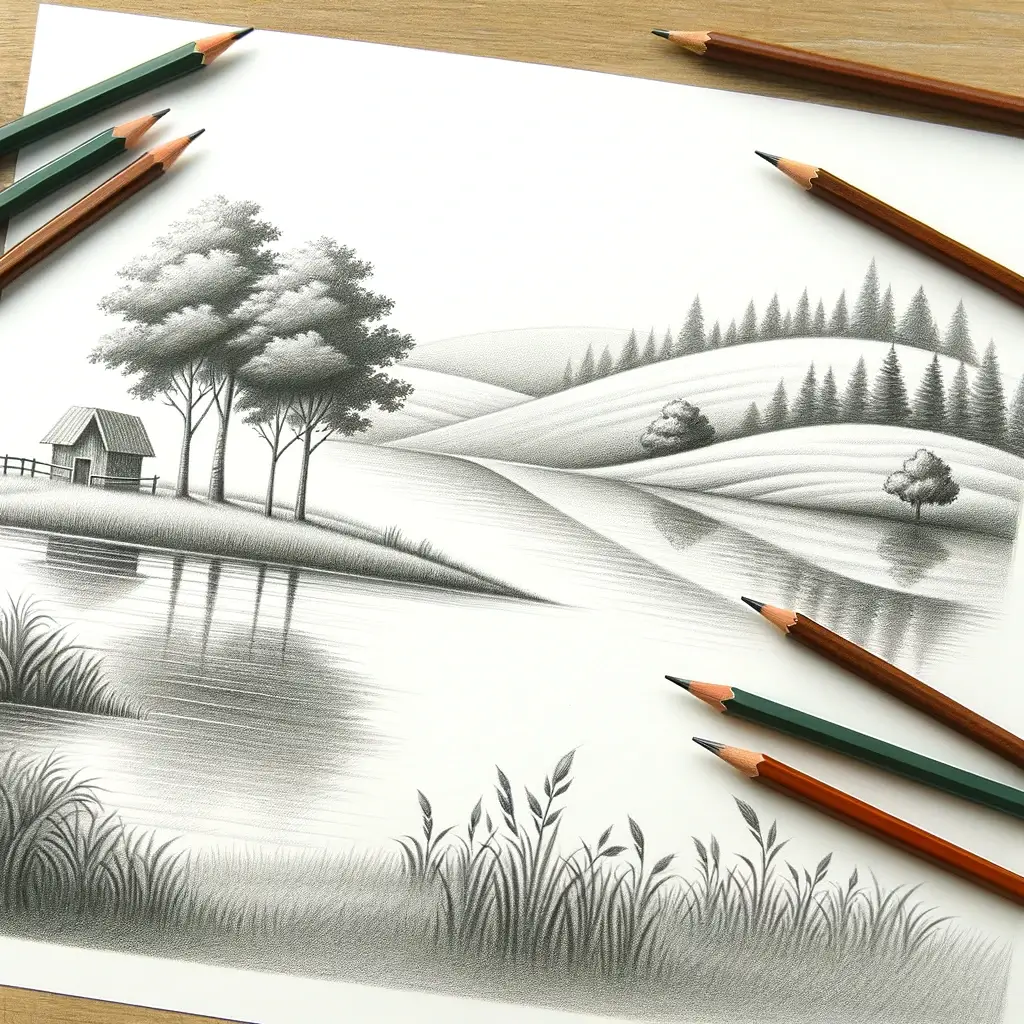
Reflecting on Your Artistic Journey
Your artistic journey is unique, and reflecting on it is a crucial part of your growth. Take time to look through your old drawings and appreciate how far you’ve come. Ask yourself:
- What new techniques have I learned?
- How has my understanding of light and shadow improved?
- What subjects or scenes do I enjoy drawing the most?
Reflection isn’t just about patting yourself on the back; it’s about setting goals for the future and deciding what new challenges you want to tackle next. Maybe you want to delve deeper into figure drawing or master cross hatching to add texture to your landscapes.
Capturing the beauty of the world in your sketchbook is a remarkable feat, and every step forward is a reason to celebrate. Keep nurturing your passion for landscape drawing, and remember: every line, every shade, and every scene is a testament to your dedication and love for the art. Keep drawing, keep sharing, and most importantly, keep enjoying the process!


